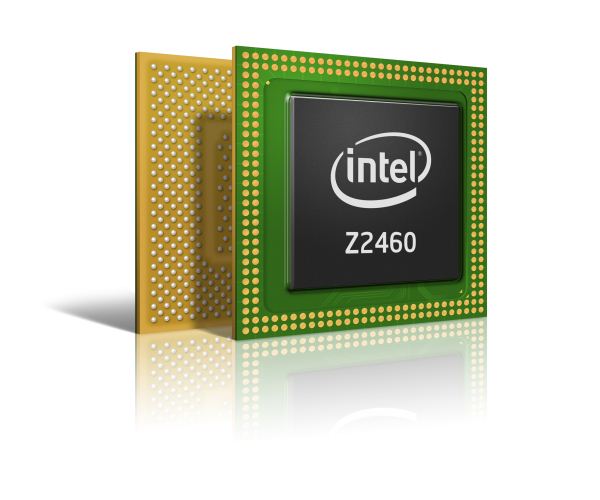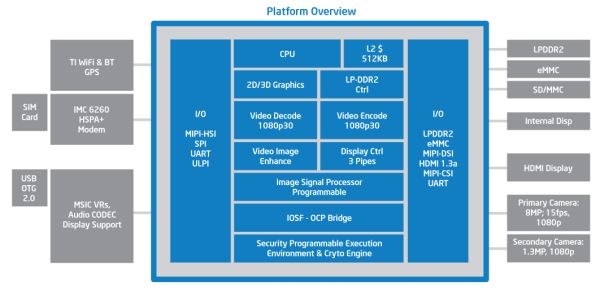Intel Goes Higher & Lower End With Atom SoCs: Z2580 & Z2000 Announced at MWC
by Anand Lal Shimpi on February 27, 2012 12:15 PM EST- Posted in
- Smartphones
- Intel
- Atom
- Mobile
- Medfield
- Tablets
- Trade Shows
- SoCs
Intel had a few updates about its Android SoC strategy for us at MWC this week. The first is a spec revision. The Atom Z2460 we talked about in great detail at CES was originally specced to run at a max of 1.3GHz but it could burst up to 1.6GHz if the thermal conditions allowed it (ala turbo boost). Z2460 yields on Intel's 32nm LP process are apparently better than expected so the Atom core will be able to turbo up to 2.0GHz instead of 1.6GHz. The default max frequency remains unchanged at 1.3GHz.
Next, Intel announced two new Atom SoCs for the smartphone market: the Z2580 and the Z2000.
The Z2580 is a higher end part, back from the fab now but shipping in devices in the first half of next year. It features the same architecture as the Atom Z2460 but instead of a single Saltwell core it has two, with Hyper Threading enabled (2 cores, 4 threads). The CPU cores can burst at up to 1.8GHz, while the default max CPU frequency remains at 1.3GHz.
The CPU isn't the only part of the SoC to get an upgrade: Intel equipped the Z2580 with a PowerVR SGX 544MP2 GPU running at 533MHz. The SGX 544 is similar to the 543 used in Apple's A5, however it adds support for Direct3D 9_3. At 533MHz you can expect roughly twice the shader/compute performance of the 543MP2 that's in the A5. Granted by early next year we'll likely see competitive, if not faster GPUs implemented in SoCs (quite possibly long before then).
The Z2580 will be paired with Intel's XMM 7160 LTE baseband. The 7160 is an upgraded version of the XMM 7060 that adds support for 3GPP Release 9. The full specs of the solution are below:
| Intel XMM7160 LTE | ||||||
| 3GPP Rel.9, FDD-LTE Cat 3 (100Mbps DL/50Mbps UL); CSFB, capable for VoLTE, SRVCC, E911 over LTE. TDD-LTE/TD-SCDMA | ||||||
| 3GPP Rel.9, DC-HSPA+ Cat 20&24/Cat7 (42Mbps DL/11.5Mbps UL) | ||||||
| 2G Quad-Band 850/900/1800/1900 MHz | ||||||
| HSPA+/UMTS Penta-Band 850/900/1900/2100/AWS MHz | ||||||
| LTE Hepta-Band 850/1800/1900/2100/AWS/2600/700 or 800 MHz | ||||||
| Android telephony framework and UI extensions | ||||||
The Z2580 also received upgrades on the modem interface side to cope with the increased bandwidth from the LTE baseband. Remember the Z2460 launched with a HSPA+ baseband pair (XMM6260).
Just like with the Z2460, Intel has produced a FFRD (Form Factor Reference Design) based around the Z2580/XMM7160. I don't have photos (nor have I seen) the new high-end FFRD, but I'm told it's a better looking design than the current Medfield design. The only detail I have about the new reference design is it comes with a larger battery: 6.771Whr.
The Z2580/XMM7160 FFRD will begin sampling in the second half of this year, with customer units shipping in the first half of next year.
| Intel Android Atom SoC Comparison | ||||||
| Low End | Mid Range | High End | ||||
| Name | Intel Atom Z2000 | Intel Atom Z2460 | Intel Atom Z2580 | |||
| CPU Clock (base/turbo) | 1.0GHz | 1.3GHz/2.0GHz | 1.3GHz/1.8GHz | |||
| GPU | PowerVR SGX 540 | PowerVR SGX 540 | PowerVR SGX 544MP2 | |||
| GPU Clock | 320MHz | 400MHz | 533MHz | |||
| Process Technology | Intel 32nm LP | Intel 32nm LP | Intel 32nm LP | |||
| Availability | 1H 2013 | 1H 2012 | 1H 2013 | |||
The Z2000 is Intel's new low-end Atom SoC SKU. While the Z2580 has two Atom cores, the Z2000 only has one. Max clock speed is limited to 1GHz and there is no support for Hyper Threading. Intel is planning on putting this core up against the ARM11 based SoCs that still sell into the low end of the smartphone space.
The GPU remains unchanged from the Z2460 (PowerVR SGX 540) however the max clock speed is limited to 320MHz (down from 400MHz). 1080p video decode is supported but video encode is limited to 720p.
The Z2000 will be paired with Intel's XMM6265 HSPA+ baseband:
| Intel XMM6265 | ||||||
| HSPA+ Rel.7, Cat 14/Cat6 (21Mbps DL/5.8Mbps UL) | ||||||
| 2G Quad-Band 850/900/1800/1900 MHz; GPRS EDGE Class 10 | ||||||
| HSPA+/UMTS Tri-Band 900/1900/2100 MHz (I/II/VIII) | ||||||
The Z2000 has its own form factor reference design, which is different from both the Z2460 and Z2580. Once again I only have a single piece of information Reference designs are especially important at the low end as they can save customers quite a bit of money. With narrow margins there's not a whole lot of room to spend on industrial design or hardware customizations. A turnkey solution that's well built and reliable will be very useful for this market.
| Intel FFRD Comparison | ||||||
| Low End | Mid Range | High End | ||||
| SoC | Intel Atom Z2000 | Intel Atom Z2460 | Intel Atom Z2580 | |||
| Modem Pairing | Intel XMM6265 | Intel XMM6260 | Intel XMM7160 | |||
| Length | 110.5mm | 123.0mm | ? | |||
| Width | 61.0mm | 63.0mm | ? | |||
| Height | 12.5mm | 9.99mm | ? | |||












25 Comments
View All Comments
A5 - Monday, February 27, 2012 - link
That Z2580/XMM7160 combo would have been more exciting if not for two things:1) Qualcomm is going be shipping an LTE-A baseband in Q4 2012. Network support will be coming in 2013, so it is more of a "nice to have", but still...
2) Like you said in the article, that GPU will probably be behind the curve by Q1 2013. CPU performance will probably still compare favorably to Krait/Tegra 4/etc, though. Should be interesting times.
iamlilysdad - Monday, February 27, 2012 - link
We'll also have TI's OMAP 5 with the all new A15 cores by then.A5 - Monday, February 27, 2012 - link
Hence the "etc".klmccaughey - Monday, February 27, 2012 - link
Here is a video: http://www.youtube.com/watch?v=66VeS0_tAJMI look forward to the day when we can get customizeable phones from Intel for builders like us :)
The battery life seems excellent given the power.
just4U - Monday, February 27, 2012 - link
(...sigh) don't expect them to make the same mistake as IBM did back in the day. There will likely be alot of pressure from OEMs to make sure that everyday average builders are locked out. I mean think about it, we don't even really get to build our own laptops... chances of getting to build some phones are going to be fairly slim.Kumouri - Monday, February 27, 2012 - link
In the article you said 1h next year (1H 2013) for release of the 2580, but in the chart you said 1H 2012, is this a typo? Just want to make sure :)lilmoe - Monday, February 27, 2012 - link
I can see how java and devlik cache can also run on x86 (since java is portable by nature), but wouldn't that require a LOT of optimization before an OEM can release a phone? What about updates? It would even extend the delay problems of updates and bug-fixes. There are other technologies that are (currently) ARM dependent such as Renderscript, and now we're talking about android kernel app development... I can only see this making Android more fragmented since devs will also now need to optimize their applications/apps for x86...On the other hand, a viable market would be an x86 version of Windows Phone 8 (hint: PowerVR SGX 544 with DirectX compatibility). I hear that metro-style apps (also winRT apps) should transcend CPU architecture. It's still unclear whether the same WinRT app build would work on both architectures without modifications or recompiling, but if it does, then it'll be perfect, and it's just exactly what .NET should have been from the first place.
A "smaller" copy of Windows 8 for tablets (without desktop view, and only running metro-style apps) might also benefit from the new Atoms. IvyBridge (and beyond) for high end tablets, and these Atoms for lower-end budget tablets... sounds cool.
Jaybus - Monday, February 27, 2012 - link
Huh? The Renderscript compiler compiles to byte code, similar to .Net or Java. The runtime decides what to run on GPU, what to run on CPU, etc. Very similar to CUDA. Once there is a Renderscript runtime and compiler for a platform, apps using Renderscript simply need a recompile. The Renderscript compiler takes care of optimizations at the byte code level.Its much harder, in general, to develop an app for both Android and Windows than it is to develop an Android app for different hardware architectures. One of the benefits of Android's Linux roots.
Of course there has to be device drivers for any new platform's hardware, regardless of OS, but Intel has already done that. Since nearly all apps are written in high level languages and let the compilers handle optimization, I really don't think it is a big deal.
lilmoe - Monday, February 27, 2012 - link
thanks for the clarificationmosu - Monday, February 27, 2012 - link
Did Intel provide numbers regarding power envelope or max TDP for those new chips?Is Intel preparing something DX11 capable, because PowerVR is only DX9?